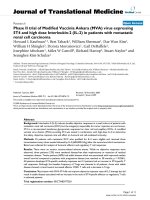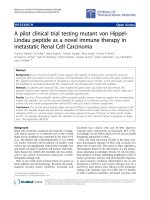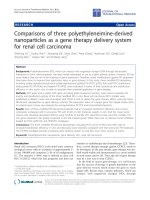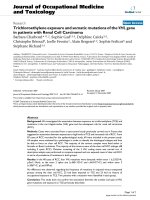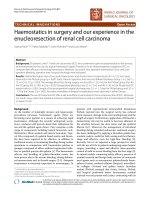A case of metastatic renal cell carcinoma and bile duct carcinoma treated with a combination of sunitinib and gemcitabine
Bạn đang xem bản rút gọn của tài liệu. Xem và tải ngay bản đầy đủ của tài liệu tại đây (731.68 KB, 7 trang )
Takayoshi et al. BMC Cancer (2015) 15:426
DOI 10.1186/s12885-015-1443-2
CASE REPORT
Open Access
A case of metastatic renal cell carcinoma and bile
duct carcinoma treated with a combination of
sunitinib and gemcitabine
Kotoe Takayoshi1, Kosuke Sagara1, Keita Uchino1*, Hitoshi Kusaba2, Naotaka Sakamoto3, Atsushi Iguchi3
and Eishi Baba4
Abstract
Background: Metastatic renal cell carcinoma (mRCC) had been a chemo-refractory disease, but recent advances in
multiple kinase inhibitors such as sunitinib have dramatically changed the clinical course of mRCC. Sunitinib is used
for mRCC chemotherapy based on the favorable results of a recent clinical trial, but specific biomarkers predicting
efficacy and safety are not yet available. Locally advanced bile duct carcinoma (BDC) has generally been treated
with single agent gemcitabine or as doublet therapy with cisplatin. Concomitant occurrence of mRCC and BDC is
extremely rare, and a standard therapeutic strategy has not been established.
Case presentation: A 65-year-old woman was diagnosed as having multiple mRCC and intercurrent, locally advanced
BDC. A single course of combination therapy with sunitinib (25 mg/day, day2-15) and gemcitabine (750 mg/m2, days 1,
8) was administered, and this showed obvious effects, with partial response for mRCC and stable disease for BDC.
However, the patient also experienced severe adverse events, including hematological and various non-hematological
toxicities; the combination therapy was then terminated on day 13 after its initiation. She recovered on day 28 and is
alive 3.5 years after the diagnosis. The plasma trough levels of sunitinib and its active metabolite SU12662 on day 13
were 91.5 ng/mL and 19.2 ng/mL, respectively, which were relatively higher than in previous reports. Analysis of her
single nucleotide polymorphisms (SNPs) detected TC in ABCB1 3435C/T, TC in 1236C/T and TT in 2677G/T, suggesting
a possible TTT haplotype.
Conclusion: A rare case of double cancer of mRCC and BDC was treated by combination chemotherapy. Although
unknown synergistic mechanisms of these agents may be involved, severe toxicities might be possibly associated with
high sunitinib exposure. Further exploration of combination therapy with sunitinib and gemcitabine is required.
Keywords: ABCB1, Adverse event, Bile duct carcinoma, Gemcitabine, Plasma concentration, Renal cell carcinoma,
Sunitinib
Background
Renal cell carcinoma (RCC) is one of the most serious
urological malignancies. mRCC is initially diagnosed in
30 % of RCC patients, and 20–40 % of curatively operated
RCC patients recur. Recently, new classes of molecular
targeted agents, such as tyrosine kinase inhibitors and
mTOR inhibitors, have become widely used for mRCC.
Sunitinib is an oral tyrosine kinase inhibitor that
* Correspondence:
1
Department of Medical Oncology, Clinical Research Institute, National
Hospital Organization Kyushu Medical Center, 1-8-1 Jigyouhama, Chuo-ku,
Fukuoka 810-8563, Japan
Full list of author information is available at the end of the article
targets vascular endothelial growth factor receptor
(VEGFR)-1, −2 and −3, platelet-derived growth factor
receptor (PDGFR)-α and -β, RET, and c-Kit. It has
often been used for mRCC chemotherapy based on the
favorable results of a phase III clinical trial showing
superiority over interferon alpha [1]. Recent studies,
however, have reported some adverse events including
fatigue, bone marrow suppression, hand-foot syndrome, stomatitis, hypertension and hypothyroidism
[1]. In a pivotal study of sunitinib, 38 % of the patients
in the sunitinib group required dose interruptions due
to adverse events, and 32 % required dose reductions
© 2015 Takayoshi et al.; licensee BioMed Central. This is an Open Access article distributed under the terms of the Creative
Commons Attribution License ( which permits unrestricted use, distribution, and
reproduction in any medium, provided the original work is properly credited. The Creative Commons Public Domain
Dedication waiver ( applies to the data made available in this article,
unless otherwise stated.
Takayoshi et al. BMC Cancer (2015) 15:426
to continue treatment courses [1]. Identifying biomarkers that can predict the response and adverse
events of sunitinib is urgently needed in order to obtain the optimal effects of this drug.
Biliary tract cancer is rare in the Western countries,
while it is relatively common in Latin America and Asia,
including in Japan [2], and 50–90 % of patients was
diagnosed as having advanced cancer and had a poor
prognosis [3]. Combination chemotherapy consisting of
fluoropyrimidine and gemcitabine has been given not
only for metastatic biliary tract cancer but also for locally advanced disease. A recent clinical study showed
the efficacy of the combination of gemcitabine and platinum for metastatic biliary tract cancer [4, 5]. While
adverse events of gemcitabine such as myelosuppression,
liver dysfunction, general fatigue, alopecia, and nausea
were often observed, they were mostly tolerable in the
pivotal clinical studies.
Concurrent occurrence of RCC and BDC is extremely
rare. Only two cases have been reported in the literature,
and the biological background of the synchronous primary malignancy was not clarified [6, 7]. Standard therapeutic strategies have generally not been established for
cases of unresectable double primary cancers, and no
chemotherapy was given to the above two cases. In the
present case with concurrent mRCC and BDC, combination therapy of sunitinib and gemcitabine, which are
both effective agents for each disease, was used, and
both response and various adverse events were seen.
Plasma concentrations of sunitinib and SU12662 were
Page 2 of 7
measured to assess the clinical effects induced by the
combination therapy. Polymorphisms of specific genes
encoding for metabolizing enzymes, efflux transporters,
and drug targets involved in the pharmacokinetics (PK)
and pharmacodynamics (PD) of sunitinib were also
examined.
Case presentation
Case report
A 65-year-old woman was diagnosed with clear cell RCC
in June 1998 and underwent radical left nephrectomy
(pT2N0M0). Her disease status was good risk by Memorial Sloan Kettering Cancer Center criteria, and she
was followed closely without therapy after the surgery.
In December 2003, computed tomography (CT) showed
multiple lung metastases. Interferon alfa-2a and sorafenib were administered sequentially. In August 2011, the
tumor eventually progressed (Fig. 1a), and serum bilirubin and liver enzymes increased rapidly. Endoscopic
retrograde cholangiopancreatography and magnetic resonance cholangiopancreatography examinations revealed
narrowing with an irregular intraductal lumen of the
area from the upper common bile duct to bilateral intrahepatic bile ducts (Fig. 1c). Cholangioscopy showed that
the luminal mucosa was circumferentially narrowed with
an irregular reddish surface. These findings were not
likely to be metastatic RCC. She was diagnosed with
upper BDC (T2N1M0). Endoscopic placement of a biliary stent immediately improved the bilirubin and liver
enzyme levels in two days. Surgical resection of her
Fig. 1 Images in clinical course: a Chest CT scan of lung metastases before introduction of sunitinib and gemcitabine. b Chest CT scan of lung
metastases on day 20 after the administration. c Magnetic resonance cholangiopancreatography image demonstrated narrowing from upper
common bile duct to bilateral intrahepatic bile ducts (arrow)
Takayoshi et al. BMC Cancer (2015) 15:426
BDC for the purpose of local control was not suitable
because of RCC metastases. Because both cancers had a
strong effect on her prognosis, treatment for both diseases was considered necessary. Thus, treatment consisting of 21-day cycles of sunitinib (25 mg/day; days 2–15
on, days 1 and 16–21 off ) and gemcitabine (750 mg/m2
on days 1 and 8) was initiated [8], and the treatment was
discontinued on day 14 due to various adverse events.
Hematological toxicities of the National Cancer Institute
Common Terminology Criteria for Adverse Events (NCI
CTCAE, version 4.0) grade3 thrombocytopenia and neutropenia were noted on day 15. Non-hematological toxicities, depressed consciousness (Grade 1) and fever (Grade
2) were observed. CT and magnetic resonance imaging
(MRI) examination did not suggest organic intracranial lesions, and the symptoms improved in 4 days. Lung congestion, respiratory distress, and hypoxemia (Grade 3)
appeared on day 23. Echocardiography showed preserved
cardiac function, and the brain natriuretic peptide (BNP)
concentration was normal. No evidence of infectious
diseases was detected. The other toxicities included syndrome of inappropriate secretion of antidiuretic hormone
(SIADH) (Grade 3), increased ALP and γGTP (Grade 3),
increased lipase (Grade 3), and hypothyroidism (Grade 2).
All toxicities improved on day 28. In this case, hand-foot
syndrome and stomatitis were not observed. In terms of
efficacy, CT examination on day 20 showed a significant
decrease in size of the lung metastases (Fig. 1b). The response of the lung metastases of RCC and no significant
change for BDC were confirmed on day 35. She had subsequent temsirolimus monotherapy from January 2012
and it achieved tumor control for about 12 months. She is
now under best supportive care 3.5 years after the initial
chemotherapy.
Pharmacokinetic sampling
The plasma levels of sunitinib and SU12662 were analyzed
on days 13, 17, 21, 23, 27, and 33 using the highperformance liquid chromatography technique [9]. Peripheral blood was obtained before taking sunitinib on days
13, 17, 21, 23, 27 and 33. Then, samples (0.5 ml) were collected in tubes containing ethylenediamine tetraacetic acid
(EDTA). Samples were centrifuged at 3500 rpm at 4 °C
for 10 min, and 0.1 N NaOH was added to the supernatants. The compounds were extracted into 3 ml t-butyl
methyl ether (TBME). After agitation for 5 min, the
TBME phase was aspirated and evaporated to dryness
(N2). Aliquots were subjected to high-performance liquid
chromatography.
High-performance liquid chromatography
The chromatographic system consisted of a mobile
phase of a mixture [0.05 M phosphoric buffer (pH 3),
acetonitrile, and B-7 low UV regent (Waters, Milford,
Page 3 of 7
MA, USA) at a ratio of 695:300:5] with an ODS column
pumped at a flow rate of 0.3 ml/min and UV/VIS detection at 431 nm (0–12 min) and 250 nm (12–20 min). Sunitinib and SU12662 were purchased from TRC (Toronto
Research Chemicals, Ontario, Canada). The internal standard was 4-methyl-mexirethyn [9]. The retention times for
SU12662, sunitinib and the internal control were 5.8, 8.3
and 14.8 min, respectively.
DNA sample preparation
The patient gave written, informed consent to participate
in the present study. Genomic DNAs were extracted from
whole blood (500 μL) by the SMITEST EX-R&D Nucleic
Acid Extraction Kit (MBL Co., LTD. Nagoya, Japan). The
concentration of the DNA was adjusted to 50 ng/μL.
Genotyping of SNPs
ABCG2 polymorphism (−15662C/T) was genotyped
using genomic polymerase chain reaction (PCR) and
direct sequencing. Five μL of human genomic DNA
(10 ng/μL), 20 μL of amplification reaction mixture,
and 0.625 units Taq DNA polymerase were placed in
reaction tubes. Amplification of the reaction mixture
was carried out in 50 mM KCl, 10 mM Tris–HCl
(pH 8.3), 1.5 mM MgCl2, 2 % dimethyl sulfoxide (DMSO),
and 0.2 mM dNTPs, 0.2uM each of primers (FP: 5’ACCCTGTCTGTCTCTACTAA-3’, RP: 5’-GTGATTA
CATTAAATGAGGTC-3’). PCR reactions were performed
for 40 cycles, with denaturation at 94 °C for 30 s, annealing at 56 °C for 30 s, and extension at 72 °C for 30 s using
a GeneAmp PCR System 9700 (Life Technologies). The
sequence reaction was run in the ABI 3700 DNA analyzer
(sequencing primer: 5’-CAACTCTCACCTATGAGTGA3’) and analyzed using Sequencer computer software
(Gene Codes Corporation, Ann Arbor, MI). Other polymorphisms, NR1I3 (5719C/T, 7738A/C, 7837 T/G),
CYP1A1 (2455A/G), ABCG2 (1143C/T, 34G/A, 421C/A),
ABCB1 (3435C/T, 1236C/T, 2677G/T), VEGFR2 (1191C/
T) and FLT3 (738 T/C), were genotyped using the Illumina Human OmniExpress-12 BeadChip (Illumina Inc.,
San Diego, CA). A total of 200 ng of DNA (4 μL at 50 ng/
μL) for the sample was processed according to the Illumina Infinium HD Assay Ultra protocol. BeadChip was
imaged on the Illumina iScan System with iScan Control
Software (v3.3.28). Normalization of raw image intensity
data, genotype clustering, and individual sample genotype
calls were performed using the Illumina GenomeStudio
software (v2011.1), Genotyping Module (v1.9.4).
Results
After administration of 25 mg/day of sunitinib from day
2 to day 13, the plasma trough concentrations were
91.5 ng/mL, decreasing to half on day 17. The plasma
trough concentration of SU12662 was 19.2 ng/mL on
Takayoshi et al. BMC Cancer (2015) 15:426
Page 4 of 7
day 13, and it also decreased on day 17 (Fig. 2). The
patient’s condition gradually recovered following the decreases in the plasma levels. This suggests that the high
plasma levels of sunitinib and SU12662 were possibly responsible for both the efficacy and toxicities observed in
this case.
Gene polymorphisms that have been reported to be
candidate SNPs related to the exposure and metabolism
of sunitinib were analyzed (Table 1). In this case, TC in
ABCB1 3435C/T, TC in 1236C/T and TT in 2677G/T
were detected, and then there were two possibilities:
TTT haplotype and TCT haplotype. CC in ABCG2 type,
CC in -15622C/T, and CC in C421A type were also
detected.
Table 1 SNPs and the genotypes in 13 previously
reported genes
Discussion
Synchronous primary BDC was diagnosed during the
course of metastatic RCC in this case. Although cytological and histological confirmation for BDC was not
obtained, a series of radiological examinations showed
typical findings of primary BDC rather than mRCC.
RCCs due to hereditary cancer syndromes including
Von Hippel-Lindau disease [10] and Birt-Hogg-Dube
syndrome [11] are known to be associated with colon,
breast, and ovarian cancers. On the other hand, BDC
has been reported to be intercurrent with primary hepatocellular carcinoma [12] However, the synchronous occurrence of RCC and BDC is extremely rare, and the
genetic backgrounds are unclear. To the best of our
knowledge, this is the first report of systemic chemotherapy for a patient with concomitant RCC and BDC.
Combination therapy with sunitinib and gemcitabine,
used in this case, was examined in a phase I trial for patients with advanced solid tumors [13]. Patients were
given 25–37.5 mg/body daily of sunitinib, and 800 mg/m2
on days 1, 8 and 15 or 675 mg/m2 on days 1 and 8 of gemcitabine. In all patients groups, grade 3/4 hematological
ABCB1
2677C/T
rs2032582
TT
VEGFR2
1191C/T
rs2305948
CC
FLT3
738 T/C
rs1933437
TC
Gene
SNPs
rs Number
Genotype
NR1I3
5719C/T
rs2307424
TC
NR1I3
7738A/C
rs2307418
AA
NR1I3
7837 T/G
rs4073054
TG
CYP1A1
2455A/G
rs1048943
AA
ABCG2
1143C/T
rs2622604
CC
ABCG2
−15622C/T
rs55930652
CC
ABCG2
34G/A
rs2231137
GG
ABCG2
421C/A
rs2231142
CC
ABCB1
3435C/T
rs1045642
TC
ABCB1
1236C/T
rs1128503
TC
toxicities were observed for neutropenia (54 %), febrile
neutropenia (6 %), thrombocytopenia (18 %), and anemia
(12 %). Michaelson et al. assessed two different schedules
of the combination therapies of (a) sunitinib on a 4weeks-on-2-weeks-off schedule (Schedule 4/2) plus
gemcitabine on days 1, 8, 22 and 29, and (b) sunitinib on a
2-weeks-on-1-week-off schedule (Schedule 2/1) plus gemcitabine on days 1 and 8 [14]. In three patients on Schedule 2/1 with 37.5 mg of sunitinib and 750 mg/m2 of
gemcitabine, two patients showed grade 3 neutropenia
and lymphopenia, and one patient had grade 3 leukopenia.
Increments of the doses of both drugs induced grade 4
hematological and non-hematological toxicities, but no
significant drug-drug interaction was suggested.
A case of pancreatic cancer and RCC that was treated
with combination chemotherapy with 37.5 mg of sunitinib
Fig. 2 Plasma concentrations of Sunitinib (solid circle) and SU12662 (solid square) are shown. Horizontal axis indicates days after initiation of
sunitinib administration
Takayoshi et al. BMC Cancer (2015) 15:426
(4-weeks-on-2-weeks-off) and 750 mg/m2 of gemcitabine
on day 1, 8 and 15 was also reported. Two courses of the
therapy achieved high relative dose intensity and partial responses. Although the dose of gemcitabine was decreased
because of neutropenia, the therapy was safely continued
for 25 weeks [15].
Comparing these reports, the present case experienced relatively intense and various adverse events
even though lower doses of drugs were administered.
Since hematological toxicities and liver toxicity were
also observed in the previous reports, they might be
caused by the combination therapy. On another front,
hypothyroidism was thought to be induced by sunitinib
and pulmonary edema might be caused by the acceleration of vascular endothelial growth factor (VEGF) via
sunitinib.
One of the possible reasons for the enhancement of
adverse events was suggested to be the elevated plasma
concentration of sunitinib. A positive correlation between
plasma concentration of sunitinib and adverse events was
reported by Houk [16]. The previous phase I trial also
showed that sunitinib-induced toxicities appeared in a
dose-dependent manner [13]. Plasma trough concentrations of sunitinib and SU12662 were 91.5 ng/mL and
19.2 ng/mL, respectively, on day 13, when the trough concentrations might be in a steady-state. Daily administration
of sunitinib alone in Japanese patients with pancreatic
endocrine tumors showed mean dose-corrected (reference
dose: 37.5 mg) Ctrough values that were within the range of
41.7-53.9 ng/mL for sunitinib, 19.6-25.7 ng/mL for
SU12662, and 62.9-77.5 ng/mL for total drug [17]. In terms
of PK analysis of the combination of sunitinib and gemcitabine, the Cmax of sunitinib on day 8 of 50 mg daily administration was 71.5 ng/mL (CV% 58) (median 60.0) and that
of SU12662 was 27.5 ng/mL (CV% 68) (median 20.9) [14].
Although direct comparison between the values of Cmax
and trough concentration is difficult, and data on the
trough concentration in combination therapy are not available, the plasma trough concentrations of sunitinib and
SU12662 in the present case were relatively high.
The plasma concentration of sunitinib is regulated by
various factors, including drug-transporters in epithelial
cells of the gastrointestinal tract for absorption of the
drug. Sunitinib was thought to be a substrate for ATPbinding transporters ABCG2 and ABCB1 [18–20]. It has
been reported that the TTT haplotype of ABCB1 was generally associated with decreased expression of ABCB1 and
subsequent higher-exposure of its substrates [21, 22]. In
addition, van Erp et al. reported that TTT haplotype was
associated with the risk of hand-foot syndrome with sunitinib [23]. However, Garcia-Donas demonstrated that the
ABCB1 polymorphisms were not significantly associated
with the efficacy and toxicities of sunitinib [24]. While the
ABCB1 haplotype of the present case was possibly TTT
Page 5 of 7
type, hand-foot syndrome did not appear. Therefore, the
relationships between ABCB1 polymorphism and the high
plasma concentrations of sunitinib and SU12662 were not
clarified. Sunitinib has also been reported to be a substrate
for ABCG2, and its polymorphism of 421C/A was
correlated with increased exposure of sunitinib [25]. In
addition, TT haplotypes of ABCG2 -15622C/T, and
1143C/T showed increased risks of adverse events [23].
These series of ABCG2 polymorphisms were not found
in the present case.
The drug-metabolizing enzyme CYP3A4 is a key enzyme in sunitinib metabolism, and NR1I3 is one of the
regulating factors of CYP3A4 expression [26]. CYP1A1
is known to be associated with the metabolism of tyrosine kinase inhibitors. Since these might possibly affect
the plasma concentration of sunitinib, polymorphisms
of these factors were also examined in this case, but no
significant correlation was found. Therefore, polymorphisms of specific genes, which might be closely associated with the PK of sunitinib, could not be eliminated
as possible reasons for the high exposure of sunitinib
and various adverse events; other factors should be
considered.
In the present study, PK analysis of gemcitabine could
not be performed. However, to the best of our knowledge, gemcitabine does not induce or inhibit CYP450,
and it is not a substrate of ABCB1 and ABCG2. CYP3A4
has not been known to be involved in gemcitabine metabolism [14]. Therefore, it is less likely that combination
use of gemcitabine might affect the plasma concentration of sunitinib.
After submission of this manuscript, several clinical
studies employed the combination of sunitinib and gemcitabine had been published. A randomized phase II
study in advanced pancreatic cancer demonstrated the
combination regimen could not show sufficient superior
efficacy compared to gemcitabine monotherapy but was
associated with more toxicity [27]. Triplet regimens consisting of the combination and cisplatin or capecitabine
in advanced solid tumors exhibited prominent toxicities
suggesting difficulties of further developments of triplet
regimens [28, 29].
Conclusions
An extremely rare case of the concomitant occurrence of
RCC and BDC was treated by combination therapy with
sunitinib and gemcitabine, and clinical response was
achieved. Various adverse events might be associated with
increased plasma concentrations of sunitinib. Possible
mechanisms of high exposure of sunitinib might include gene polymorphisms of drug-transporters, but
unknown mechanisms induced by the combination use
of two drugs should be investigated. Combination
chemotherapy against double cancers requires more
Takayoshi et al. BMC Cancer (2015) 15:426
careful management, and it is important to identify adequate biomarkers for predicting efficacy and toxicities.
Page 6 of 7
8.
9.
Consent
Written informed consent was obtained from the patient
for publication of this Case report and any accompanying
images. A copy of the written consent is available for review
by the Series Editor of this journal.
10.
11.
Abbreviations
mRCC: Metastatic renal cell carcinoma; BDC: Bile duct cancer; SNPs: Single
nucleotide polymorphisms; RCC: Renal cell carcinoma; VEGFR: Vascular
endothelial growth factor receptor; PDGFR: Platelet-derived growth factor
receptor; PK: Pharmacokinetics; PD: Pharmacodynamics; CT: Computed
tomography; NCI CTCAE: National Cancer Institute Common Terminology
Criteria for Adverse Events; MRI: Magnetic resonance imaging; BNP: Brain
natriuretic peptide; SIADH: Syndrome of inappropriate secretion of
antidiuretic hormone; EDTA: Ethylenediamine tetraacetic acid; TBME: t-butyl
methyl ether; PCR: Polymerase chain reaction; VEGF: Vascular endothelial
growth factor.
12.
Competing interests
The authors declare that they have no competing interests.
16.
Authors’ contributions
KT, KS and KU were involved in the clinical treatment of the patient and
contributed writing the manuscript. HK, NS, AI and EB were involved in the
clinical treatment advices of the patient and contributed writing the
manuscript. All authors read and approved the final manuscript.
13.
14.
15.
17.
18.
Acknowledgements
The authors would like to thank Dr. Yoshihiko Katsuyama and colleagues for
technical support for measurement of plasma concentration of sunitinib, Dr.
Yuji Miura for advise for measurement of plasma concentration of sunitinib.
Author details
1
Department of Medical Oncology, Clinical Research Institute, National
Hospital Organization Kyushu Medical Center, 1-8-1 Jigyouhama, Chuo-ku,
Fukuoka 810-8563, Japan. 2Department of Medicine and Biosystemic Science,
Kyushu University Graduate School of Medical Sciences, Fukuoka, Japan.
3
Department of Urology, National Hospital Organization Kyushu Medical
Center, Fukuoka, Japan. 4Department of Comprehensive Clinical Oncology,
Faculty of Medical Sciences, Kyushu University, Fukuoka, Japan.
Received: 10 January 2014 Accepted: 15 May 2015
References
1. Motzer RJ, Hutson TE, Tomczak P, Michaelson MD, Bukowski RM, Rixe O,
et al. Sunitinib versus interferon alfa in metastatic renal-cell carcinoma. N
Engl J Med. 2007;356(2):115–24.
2. Randi G, Malvezzi M, Levi F, Ferlay J, Negri E, Franceschi S, et al. Epidemiology
of biliary tract cancers: an update. Ann Oncol. 2009;20(1):146–59.
3. Ramirez-Merino N, Aix SP, Cortes-Funes H. Chemotherapy for
cholangiocarcinoma: an update. World J Gastrointest Oncol. 2013;5(7):171–6.
4. Valle J, Wasan H, Palmer DH, Cunningham D, Anthoney A, Maraveyas A,
et al. Cisplatin plus gemcitabine versus gemcitabine for biliary tract cancer.
N Engl J Med. 2010;362(14):1273–81.
5. Okusaka T, Nakachi K, Fukutomi A, Mizuno N, Ohkawa S, Funakoshi A, et al.
Gemcitabine alone or in combination with cisplatin in patients with biliary
tract cancer: a comparative multicentre study in Japan. Br J Cancer.
2010;103(4):469–74.
6. Zhang X, Zhou ZH, Cai SW, Dong JH. Papillary carcinoma of the duodenum
combined with right renal carcinoma: a case report. World J Surg Oncol.
2013;11:30.
7. Levy BF, Nisar A, Karanjia ND. Cholangiocarcinoma, renal cell carcinoma and
parathyroid adenoma found synchronously in a patient on long-term
methotrexate. HPB (Oxford). 2006;8(2):151–3.
19.
20.
21.
22.
23.
24.
25.
26.
27.
Pandya SS, Mier JW, McDermott DF, Cho DC. Addition of gemcitabine at
the time of sunitinib resistance in metastatic renal cell cancer. BJU Int.
2011;108(8 Pt 2):E245–9.
Hashita T, Katsuyama Y, Nakamura K, Momose Y, Komatsu D, Koide N, et al.
Treatment of a GIST patient with modified dose of sunitinib by
measurement of plasma drug concentrations. Oncol Lett. 2012;4(3):501–4.
Maher ER, Yates JR, Harries R, Benjamin C, Harris R, Moore AT, et al. Clinical
features and natural history of von Hippel-Lindau disease. Q J Med.
1990;77(283):1151–63.
Lu X, Wei W, Fenton J, Nahorski MS, Rabai E, Reiman A, et al. Therapeutic
targeting the loss of the birt-hogg-dube suppressor gene. Mol Cancer Ther.
2011;10(1):80–9.
Jarnagin WR, Weber S, Tickoo SK, Koea JB, Obiekwe S, Fong Y, et al.
Combined hepatocellular and cholangiocarcinoma: demographic, clinical,
and prognostic factors. Cancer. 2002;94(7):2040–6.
Brell JM, Krishnamurthi SS, Rath L, Bokar JA, Savvides P, Gibbons J, et al.
Phase I trial of sunitinib and gemcitabine in patients with advanced solid
tumors. Cancer Chemother Pharmacol. 2012;70(4):547–53.
Michaelson MD, Zhu AX, Ryan DP, McDermott DF, Shapiro GI, Tye L, et al.
Sunitinib in combination with gemcitabine for advanced solid tumours: a
phase I dose-finding study. Br J Cancer. 2013;108(7):1393–401.
Bharthuar A, Pearce L, Litwin A, LeVea C, Kuvshinoff B, Iyer R. Metastatic
pancreatic adenocarcinoma and renal cell carcinoma treated with
gemcitabine and sunitinib malate. A case report. JOP. 2009;10(5):523–7.
Houk BE, Bello CL, Poland B, Rosen LS, Demetri GD, Motzer RJ. Relationship
between exposure to sunitinib and efficacy and tolerability endpoints in
patients with cancer: results of a pharmacokinetic/pharmacodynamic
meta-analysis. Cancer Chemother Pharmacol. 2010;66(2):357–71.
Ito T, Okusaka T, Nishida T, Yamao K, Igarashi H, Morizane C, et al. Phase II
study of sunitinib in Japanese patients with unresectable or metastatic,
well-differentiated pancreatic neuroendocrine tumor. Invest New Drugs.
2013;31(5):1265–74.
Hu S, Chen Z, Franke R, Orwick S, Zhao M, Rudek MA, et al. Interaction of
the multikinase inhibitors sorafenib and sunitinib with solute carriers and
ATP-binding cassette transporters. Clin Cancer Res. 2009;15(19):6062–9.
Tang SC, Lankheet NA, Poller B, Wagenaar E, Beijnen JH, Schinkel AH.
P-glycoprotein (ABCB1) and breast cancer resistance protein (ABCG2) restrict
brain accumulation of the active sunitinib metabolite N-desethyl sunitinib.
J Pharmacol Exp Ther. 2012;341(1):164–73.
Tang SC, Lagas JS, Lankheet NA, Poller B, Hillebrand MJ, Rosing H, et al.
Brain accumulation of sunitinib is restricted by P-glycoprotein (ABCB1) and
breast cancer resistance protein (ABCG2) and can be enhanced by oral
elacridar and sunitinib coadministration. Int J Cancer. 2012;130(1):223–33.
Aarnoudse AJ, Dieleman JP, Visser LE, Arp PP, van der Heiden IP, van Schaik
RH, et al. Common ATP-binding cassette B1 variants are associated with
increased digoxin serum concentration. Pharmacogenet Genomics.
2008;18(4):299–305.
Hawwa AF, McKiernan PJ, Shields M, Millership JS, Collier PS, McElnay JC.
Influence of ABCB1 polymorphisms and haplotypes on tacrolimus
nephrotoxicity and dosage requirements in children with liver transplant. Br
J Clin Pharmacol. 2009;68(3):413–21.
van Erp NP, Eechoute K, van der Veldt AA, Haanen JB, Reyners AK,
Mathijssen RH, et al. Pharmacogenetic pathway analysis for determination
of sunitinib-induced toxicity. J Clin Oncol. 2009;27(26):4406–12.
Garcia-Donas J, Esteban E, Leandro-Garcia LJ, Castellano DE, del Alba AG,
Climent MA, et al. Single nucleotide polymorphism associations with
response and toxic effects in patients with advanced renal-cell carcinoma
treated with first-line sunitinib: a multicentre, observational, prospective
study. Lancet Oncol. 2011;12(12):1143–50.
Mizuno T, Fukudo M, Terada T, Kamba T, Nakamura E, Ogawa O, et al.
Impact of genetic variation in breast cancer resistance protein (BCRP/
ABCG2) on sunitinib pharmacokinetics. Drug Metab Pharmacokinet.
2012;27(6):631–9.
Tirona RG, Lee W, Leake BF, Lan LB, Cline CB, Lamba V, et al. The orphan
nuclear receptor HNF4alpha determines PXR- and CAR-mediated xenobiotic
induction of CYP3A4. Nat Med. 2003;9(2):220–4.
Bergmann L, Maute L, Heil G, Rüssel J, Weidmann E, Köberle D, et al. A
prospective randomised phase-II trial with gemcitabine versus gemcitabine
plus sunitinib in advanced pancreatic cancer: a study of the CESAR Central
European Society for Anticancer Drug Research-EWIV. Eur J Cancer.
2015;51(1):27–36.
Takayoshi et al. BMC Cancer (2015) 15:426
Page 7 of 7
28. Bellmunt J, Suarez C, Gallardo E, Rodon J, Pons F, Bonfill T, et al. Phase I
study of sunitinib in combination with gemcitabine and capecitabine for
first-line treatment of metastatic or unresectable renal cell carcinoma.
Oncologist. 2014;19(9):917–8.
29. Geldart T, Chester J, Casbard A, Crabb S, Elliott T, Protheroe A, et al.
SUCCINCT: An Open-label, Single-arm, Non-randomised, Phase 2 Trial of
Gemcitabine and Cisplatin Chemotherapy in Combination with Sunitinib as
First-line Treatment for Patients with Advanced Urothelial Carcinoma. Eur
Urol. 2014;67(4):599–602.
Submit your next manuscript to BioMed Central
and take full advantage of:
• Convenient online submission
• Thorough peer review
• No space constraints or color figure charges
• Immediate publication on acceptance
• Inclusion in PubMed, CAS, Scopus and Google Scholar
• Research which is freely available for redistribution
Submit your manuscript at
www.biomedcentral.com/submit


